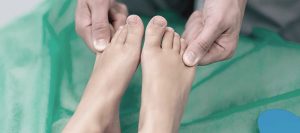
One very common problem with the tendons in our feet is fallen arches, also called flat feet. Learn more about this prevalent condition, 8 specific causes and the solutions we propose and offer to treat the discomfort, pain and mobility.
Our feet are complex machines which, when they work as they are supposed to, do an incredible job given how much pressure and stress we put on them.
But when the bones and tendons in our feet do not function like they should or if they develop in an abnormal manner, it can lead to discomfort, pain, and limits on our mobility.
One common problem with the tendons in our feet is fallen arches, also called flat feet.
What Exactly Are Fallen Arches?
When you look at your feet from the inside (the sides facing each other), you should see an elevated arch between your heel and your toes.
This arch is formed by several tendons in your feet and ankles all pulling together.
But when those tendons don’t pull together enough, the arch won’t form, leading to flat feet.
Most newborns don’t have arches in their feet, but typically develop them as they grow.
Flat feet are more common in women than they are in men, and effect adults over 40 more than they do younger people.
Many factors can contribute to fallen arches, including:
- Genetic abnormalities;
- Torn or stretched tendons;
- Damage to the posterior tibial tendon (PTT); which connects from your lower leg to the middle of the arch
- Bone fractures;
- Dislocation of bones;
- Nerve damage;
- Rheumatoid arthritis;
- Diabetes and obesity.
Why Are Fallen Arches a Problem?
When feet don’t have an arch, it can make standing and walking more difficult and painful. Common problems experienced by those with fallen arches include:
- Swelling on the inside of the ankle
- Pain or swelling of the arches
- Pain with activities or walking on uneven ground.
- Knee, hip and back pain
- Pain that worsens with activity or walking on uneven ground
- Difficulty walking or standing for long periods
Diagnosing And Treatment For Fallen Arches
As with all foot and ankle problems, fallen arches must first be diagnosed by an experienced podiatrist before they can be treated effectively.
Your podiatrist can conduct a complete evaluation as to the cause and severity of your condition.
If you do have flat feet but are not experiencing any pain or mobility challenges, your doctor may tell you no treatment is necessary.
If, however, your fallen arches are interfering with your quality of life, one or more of the following may be recommended as a course of treatment:
- Elevating the feet and applying ice to ease discomfort and reduce swelling
- Rest
- Foot stretching exercises;
- Physical therapy;
- Medication, such as anti-inflammatories;
- Steroid injections; and
- Orthotic devices, shoe modifications, braces, or casts
Contact Our Foot and Ankle Specialists at JAWS Podiatry
At JAWS Podiatry in Hollywood, Florida, we utilize the most advanced and non-invasive techniques to reduce pain and speed recovery for individuals suffering from foot and ankle problems, including fallen arches.
If you’d like to learn more about the innovative and effective treatments we provide or how we can help you with your foot and ankle issues, please call us today at (954) 922-7333 or contact us online to schedule a virtual or in-person consultation.
- The Life-Changing Power of Cosmetic Foot Surgery - February 27, 2023
- What Are The Most Common Pediatric Foot Conditions? - October 5, 2020
- 4 Important Things To Know Before Having Foot Surgery - September 21, 2020



